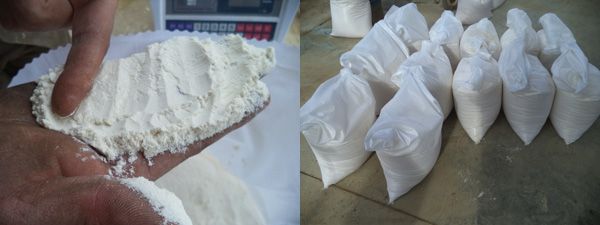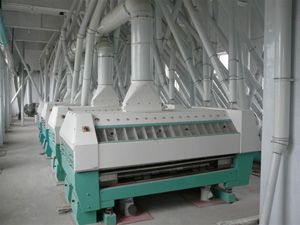Flour mill process design idea:
The design task is to produce national standard special ordinary flour. In our National Standards, the grade of all-purpose wheat flour is determined by its color, luster and bran content.
Mid grinding method means a large proportion of flour (about 35%~40%) is extracted in the middle grinding stages of the whole flour mill process (1-3 core milling), while the task of head grinding stages is to offer wheat core and semolina for core mill and scratch system rather than produce flour. The whole flour mill flow is composed by 4-5 bran mills, 6-8 core mills, 1-2 tail mills, 1-3 scratch mills and 3-4 purification systems.
After milling and sieving, a proportion of flour is sifted out, while the rest is divided into bran flake, wheat scratch and core according to particle size and quality, and these materials are delivered into corresponding systems separately: the bran flake is delivered to the following core milling for peeling and scraping, while wheat scratch and core are separated by purifying system and delivered to core mill and scratch system for processing; the wheat flour detachers in different technical parameters are also equipped to make sure final flour has better quality and lower ash content.
The features of mid grinding: the grinding is light, the mill flow is long, and there is more material classification; the outstanding advantage is that flour has good quality.

The function of bran mill is to peel wheat kernel and scrap endosperm from wheat grains, and then use flat screen to classify the particles; the wheat residue, residue that is connected with bran, and wheat core are delivered to purifying system for extracting more pure wheat residue and core. The final bran milling system is mainly used to scrap all the endosperm left on bran flake.
There are totally 5 bran mills in this system: 1st and 2nd bran mill is mainly for crushing and extracting wheat residue and core, but the flour extraction rate is low; 3Bf bran mill is mainly for grinding the wheat residue that is extracted from 2nd mill, while 3Bf is to grind the first layer screened material, and its flour extraction rate is also low; the 4th bran mill can grind coarse and fine particles separately. At the middle and end stages, there are bran brusher and bran finisher to make sure bran purity and decrease power leakage.
The scratch mill in wheat flour mill process is to process the coarse particles from bran mill, or endosperm that is connected with bran. Its grinding roller scraps lightly to separate wheat bran from endosperm; after sieving, wheat core and coarse flour with little bran are extracted, and then delivered into core mill system for extracting high quality wheat flour. At the same time scratch mill system also extract a proportion of flour.
The scratch system has 2 paths. The contacting length of scratch system grinding roller is generally 0.8-1.2mm/ (100kg wheat*24h), which takes 7% to 10% of the whole purifier grinding roller length.
As this 300ton/d flour mill adopts hard wheat as raw material, it applies the system of “first purifying, then wheat residue enters”. The main features of this process are: wide range of purifying, high extraction rate of 1st grade coarse grain particle, the material that enters scratch mill has similar quality and weight, and the grinding rotation rate is suitable for processing wheat with high hardness.
 The purifying system in wheat flour mill process is used to purify the wheat residue, core and hard coarse flour which were extracted from bran mill and scratch mill and divide them into husk, endosperm with bran and pure endosperm participles by weight. The pure wheat core is delivered to core milling system, wheat residue is delivered to scratch milling system, while wheat flakes are delivered to tail mill or fine bran mill system separately for processing. This can avoid bran and core from mixing into flour, which also increases high quality flour extraction rate.
The purifying system in wheat flour mill process is used to purify the wheat residue, core and hard coarse flour which were extracted from bran mill and scratch mill and divide them into husk, endosperm with bran and pure endosperm participles by weight. The pure wheat core is delivered to core milling system, wheat residue is delivered to scratch milling system, while wheat flakes are delivered to tail mill or fine bran mill system separately for processing. This can avoid bran and core from mixing into flour, which also increases high quality flour extraction rate.
Those material enters purifier must be graded, and flour must be cleared away. The material that enters the machine must be in uniform size, so that the operator can choose proper sieve for purifier, and it shall also be equipped with adequate amount of air flow to make sure purifying effect. Otherwise, if there is flour mixed in the material that will enter purifier, or their particles have great disparity, it is hard to guarantee these particles can evenly be spread on the sieve; as a result, the material may be pushed slowly, and small particles may be sucked away with air, which greatly decreases purifying effect.
There are totally 4 paths in purifying system. It utilizes the combined action of wind and sieve to purify coarse flour and particle, which can better decrease product ash content and increase yield.
The function of core mill system is to grind the relatively pure endosperm particles that were gained from bran mill, scratch mill and purifying system into fine flour, while at the same time decrease the breaking of wheat bran and wheat germ possibly. It can keep the quality of wheat flour. After bolting (sifting), small bran flakes are delivered into tail mill, the wheat core that has not been made into flour will be fed into next core mill for grinding again, while the flour that meets requirements will be sifted out in time.
In order to improve flour quality, the core mill system in flour mill process adopts smooth rolls, which decrease the breaking of starch granules in flour; at the same time the smooth rolls are processed by abrasive blasting, so that the roll will have rubbing to materials, and grinding effect is improved to guarantee cortex integrity and flour quality.
As the flour is easily extruded into flakes between rollers and influence sieving effect of plansifter, a wheat flour detacher is equipped in core mill system.
The incoming material of core mill system have nonuniform quality: 1M, 2M and 3M incoming material has relatively low ash content, so these 3 core mills grind a majority of flour, which is also the main source of special purpose flour. The final stage of core mill mainly produces wheat middling.
Tail mill is usually designed at the milled or end of core mill. Its function is to process tiny bran pieces from core mill, scratch mill, bran mill and purifying system, and also small particle flour that is connected with bran. After the slight grinding of tail mill, and sieving, different quality wheat core will be delivered into final core mill for grinding.